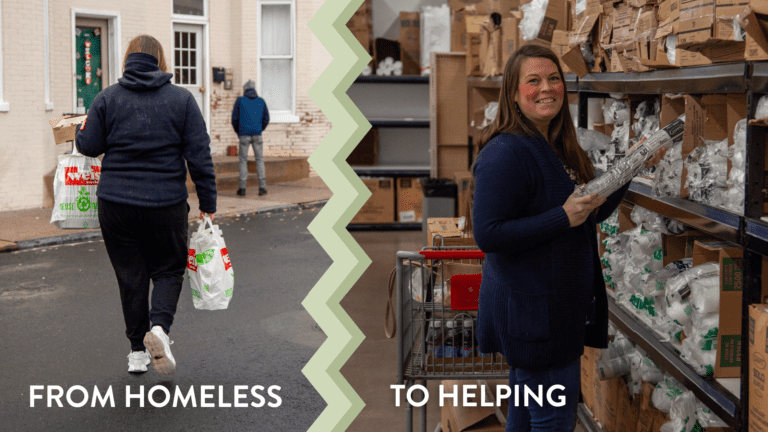
Blessings of Hope is committed in the fight to help end hunger. According to Feeding America, in Pennsylvania alone, over 1.5 million people are left hungry each day. That equates to about one out of every eight people in Pennsylvania struggling to feed themselves—and worse, over 437,000 of those are children. These struggling people are why it’s so important to support your local food bank, food pantry, or food recovery program to increase hunger awareness and to help stop it.
If it weren’t for food recovery programs and organizations like Blessings of Hope, most of the perfectly healthy food we receive would end up in a landfill—serving no one. At Blessings of Hope, we reduce food waste by taking that food and putting it to great use feeding hungry children in our communities. As a result, our food recovery efforts are able to contribute to the communities that need help the most. At Blessings of Hope, our programs enable us to take the recovered food and distribute it throughout Pennsylvania and beyond.
What is a Food Recovery Program?
A food recovery program is precisely what it sounds like—a program designed to reduce food waste and increase food opportunities for those in need. This food may come from large distributors who cannot sell products fast enough and have too much excess stock. Food producers may also have a product that does not visually meet standards for sale in restaurants and stores.
Many organizations all over the world recognize the problem with food waste and put time into food recovery efforts. A food recovery program may be as simple as reaching out to local restaurants and grocery stores to recover their excess product, or as large as national organizations that work with distributors to utilize food that was heading into landfills.
How Does a Food Recovery Program Work?
A food recovery program benefits many people—the food producers (growers, restaurants, stores), food distribution warehouses, the food bank or distribution service, the local food pantries or soup kitchens, and the families and individuals who receive the food. When a food producer has too much or unattractive product, a food bank or distribution service (like Blessings of Hope) steps in to take the excess. From there, local food organizations can help distribute food to those in need.
So, in short, a food recovery program exists when an individual or business steps in and finds a way to keep food out of landfills and get it into the hands of those who need it the most.
For example, Blessings of Hope is a food bank that recovers, stores and distributes large quantities of food so that local food pantries, soup kitchens, and other outreach programs can distribute the food to those in need. Our relationships with large producers and distributors allow us to recieve food in high quantities, but a food recovery program can work on any level within the community.
What Are Examples of Food Recovery Programs?
As we’ve discussed, food recovery programs work toward the same goal—food rescue and recovery—but may look and operate differently from one another. Below are a few food recovery programs that help to reduce food waste and work towards ending hunger.
412 Food Rescue
412 Food Rescue is a Pittsburgh-based food recovery program that works with food retailers to reduce waste. The group has an Ugly CSA (Commuity Support Agriculture) program that helps farmers sell “ugly” fruits and vegetables, and utilizes education as a tool to end hunger.
Food Cowboy
Food Cowboy uses technology to help match potential food waste with the best possible recovery efforts. From there, food banks, food pantries, or other organizations can help get food in the hands of those who need it the most.
Hungry Harvest
Hungry Harvest is a bit more commercial, as they sell much of the food they rescue. However, they pay farmers fairly for their products and donate food to donation partners for each variety box of fruits and veggies sold.
Why Do We Need Food Recovery Programs?
We need food recovery programs because, in the United States alone, 37 million people struggle every day with hunger. Food recovery programs not only help those struggling to get the food they need but also help reduce waste and create a better planet for future generations.
State of Food Insecurity
According to the USDA, food-insecure households are those that do not have constant access to food for a healthy and active life. In the United States, even though food insecurity is decreasing, it is still present at an alarming number. In 2018, 14.3 million households felt the pain of food insecurity at some point that year.
We talked previously about childhood food insecurity and how it affects the lives of those children left hungry on a regular basis. Unfortunately, food insecurity in children can lead to developmental impairment and an increased risk of childhood obesity, educational difficulties, and behavioral problems.
Food Waste by the Numbers
The Food and Agricultural Organization of the United Nations states that worldwide, 1.3 billion tons of food is wasted each year. Without reducing food waste, this will continue to cost approximately $610 billion each year for industrialized countries.
In a 2010 study from the USDA, they found that each person in the United States wastes about 218.9 pounds of food every year.
How Can You Help?
Fighting hunger is a tough fight, but with your help, we can keep making strides towards ending hunger. Organizations are a vital part of food recovery efforts, as they often have the workforce and time to start a food recovery program. However, receiving help from individuals like you is just as valuable to food recovery efforts!
We offer many volunteer opportunities for individuals and organizations with our food bank and food recovery efforts on our volunteer page.




